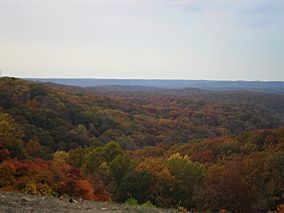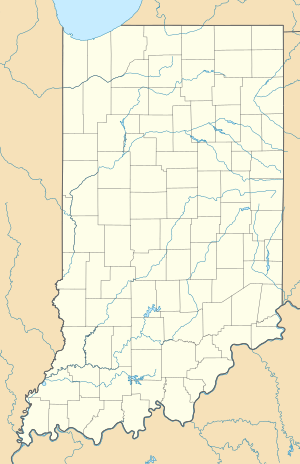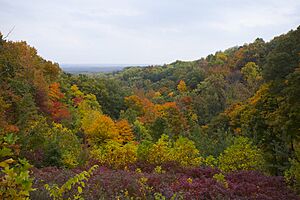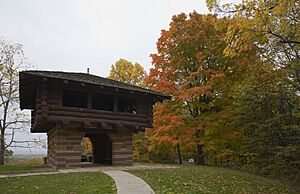Brown County State Park facts for kids
Quick facts for kids Brown County State Park |
|
|---|---|

Hesitation Point, one of several vistas in the park
|
|
| Location | Brown County, Indiana, USA |
| Nearest city | Bloomington, Indiana |
| Area | 15,776 acres (63.84 km2) |
| Established | 1929 |
| Visitors | 1,292,709 (in 2012-2013) |
| Governing body | Indiana Department of Natural Resources |
Brown County State Park is a huge park located in the middle of Indiana, United States. It's the biggest of Indiana's 24 state parks, covering about 15,776 acres. This makes it one of the largest state parks in the entire United States! Around 1.3 million people visit the park every year, making it Indiana's most popular state park.
Even though Bloomington, Indiana is the closest big city, the park is actually very near the small town of Nashville. Nashville is in Brown County, which is named after General Jacob Brown. He was a hero in the War of 1812.
The park first opened in 1929. It was officially dedicated in 1932 to honor Frank McKinney "Kin" Hubbard, a famous Indiana humorist. Hubbard often visited Nashville and the nearby forests. The park's main lodge, Abe Martin Lodge, is named after a funny character Hubbard created.
Brown County and its park are famous for their amazing views of the southern Indiana hills. Many different kinds of trees grow here. Visitors love to see the trees change into beautiful autumn colors each fall. In spring, many trees also bloom with pretty flowers. The park has a rustic feel, and many of its buildings and trails were built by the Civilian Conservation Corps in the 1930s. You can stay in the lodge, rent cabins, or camp. The park has trails for hiking, biking, and horseback riding. There are also two lakes for fishing, which add to the beauty and provide water for wildlife. Artists and photographers from all over the world come to capture the park's beauty.
Contents
Park History: How It Began
Brown County's Early Days
Brown County was formed in 1836 from parts of other counties. It got its name from General Jacob Brown, a hero from the War of 1812. Early settlers tried to farm in Brown County's hilly, wooded areas. They cut down most of the forests starting in the 1840s.
At first, large trees were cut for building wood. Later, smaller trees were used for furniture, barrels, railroad ties, and firewood. The land was rugged and hard to farm. Poor farming methods and erosion from cutting down trees made the soil lose its nutrients. Many farmers eventually left the area.
The Idea for a Park
Two main people helped create Brown County State Park. Richard Lieber, a businessman from Indianapolis, visited Brown County in 1910. He loved the land so much that he built a cabin near Nashville. He thought a part of the county should become a state park. Lieber became known as "the father of Indiana's state parks." He helped open 10 state parks, including Brown County.
Another group, the Order of Elks, also wanted a state park in Brown County in 1923.
Lee Bright, who lived in Nashville, Indiana, believed a state park would help the area's economy through tourism. But Indiana law didn't allow using state money to buy land for a park. It did allow money for a game preserve. By 1926, Bright helped buy enough land to start a game preserve in Brown County.
From Game Preserve to State Park
Brown County's game preserve opened in late 1924. A game warden was put in charge. Plans were made to replant many trees. About 7,680 acres of land were set aside for wildlife. They planned to fence the area and bring in deer and small animals. More land was added in 1927, making the preserve over 10,000 acres.
In 1927, an observation tower was built on Weed Patch Hill, the highest point around. A dam was built in 1928 to create a lake for fishing. This lake was finished by spring 1929. By January 1929, the preserve covered about 12,000 acres. Money from hunting and fishing licenses helped buy more land.
In 1927, a new law allowed counties to buy land for state parks and give it to the state. In 1929, Brown County gave 1,129 acres next to the game preserve to create a state park. This made Brown County State Park Indiana's eighth state park.
In 1933, the Civilian Conservation Corps (CCC) started working in Indiana's parks. These groups had 200 workers who built buildings, bridges, trails, and roads. They also worked to stop erosion by planting walnut, pine, and spruce trees. A second CCC camp opened in the park in 1938. Trail 2, called the CCC Trail, was built by these workers. The park was added to the National Register of Historic Places in 2020 because of the CCC's work.
In 1941, the game preserve and state park became one big park. Two parts of the park are now special nature preserves. Ogle Hollow Nature Preserve, created in 1970, has 41 acres with rare yellowwood trees. The Ten O'Clock Line Nature Preserve, created in 2010, is Indiana's largest at 3,349 acres. It also has yellowwood trees and is home to deep forest animals like the red bat, timber rattlesnake, and broad-winged hawk. The name "Ten O'Clock Line" comes from a treaty with the Miami Indians from the early 1800s.
In 1987, Indianapolis hosted the 1987 Pan American Games. Brown County State Park was used for the road race cycling competition.
Who Was Kin Hubbard?
Frank McKinney "Kin" Hubbard (1868–1930) was an American humorist and cartoonist. He shared his humor through funny characters who lived in Brown County. His cartoons and witty sayings appeared daily in the Indianapolis News and were in about 200 newspapers across the country. Hubbard was honored in the Ohio Journalism Hall of Fame in 1939 and the Indiana Journalism Hall of Fame in 1967.
Brown County State Park was dedicated in his honor in 1932. Abe Martin, Hubbard's main character, is who the park's Abe Martin Lodge is named after. You can see a picture of Hubbard in the lodge's lounge and a collection of his items nearby.
What to See and Do at the Park
Brown County State Park is the biggest of Indiana's 24 state parks. It's in the middle of southern Indiana, very close to Nashville. The park covers about 15,543 acres. It has three entrances. The northern entrance is near the Abe Martin Lodge, Saddle Barn, tennis courts, and a swimming pool. Big trucks and RVs must use the western entrance because a historic covered bridge at the northern entrance has a weight limit. Horse campers use the southeast entrance, which leads to a special campground called the Horsemen's Camp.
Brown County is famous for its beautiful outdoor scenery. The park has many viewpoints that look out over large deciduous forests. These forests show amazing colors in the fall. The most visitors come during the fall when the leaves change. In spring, dogwood, redbud, and serviceberry trees bloom. About 1.3 million people visit the park each year, including people from other countries.
Brown County State Park is sometimes called "the Little Smokies." This is because it looks a bit like the Great Smoky Mountains. You can go camping, fishing, biking, hiking, and horseback riding. Many activities are available all year. You can stay overnight in campgrounds, rental cabins, or the Abe Martin Lodge. The park has a nature center and two nature preserves.
Inside the park are two man-made lakes: the 17-acre Ogle Lake and the 7-acre Strahl Lake. The park has nine mountain bike trails that are 25 miles long. Four trails are for beginners, two are for intermediate riders, and two are advanced. The hardest trail is 4.1 miles long. There are also over 9 miles of hiking trails, from easy to rugged. The park has over 20 miles of roads and 70 miles of horse trails.
The third highest point in Indiana is on Trail 10, near a 100-foot fire tower. This spot is called Weed Patch Hill and is 1,060 feet high. When settlers first arrived, they found only weeds there because a tornado had destroyed the trees. Hesitation Point is another great spot for scenic views.
Nature in the Park
Trees and Plants (Flora)
A very important tree in the park is the yellowwood (Cladrastis lutea). This tree usually doesn't grow much farther north than central Kentucky. It's considered a state threatened species in Indiana.
Other trees in the park include at least four types of oak trees: black, chestnut, red, and white. There are also three types of hickory trees: bitternut, pignut, and shagbark. You can find at least four kinds of maple trees: black, sugar, red, and silver.
Patches of paw paw trees grow throughout the park. These trees produce an edible fruit. In moist soil, the black walnut tree grows. Other trees include the American beech, basswood, black cherry, black gum, and red elm. You'll also see sassafras, sycamore, and white ash. The park has at least eight kinds of ferns and 20 types of wildflowers, like bloodroot and wild geranium.
Animals (Fauna)
Mammals you might see in Brown County State Park include white-tailed deer, bobcats, opossum, eastern gray squirrels, and chipmunks. Larger sycamore trees are sometimes home to raccoons and flying squirrels. Red bats live in the park's Ten O'Clock Line nature preserve.
Other animals include the American toad, the eastern box turtle, the spotted salamander, and the red-backed salamander. Be careful, as two types of venomous snakes live in the park: the timber rattlesnake and the copperhead. The two lakes have bass and bluegill.
The park is great for birdwatching. You can see birds along the trails, near the lakes, and at the Nature Center. The hooded warbler, pileated woodpecker, and ruffed grouse nest here. Goldfinches and northern cardinals can be seen at feeders near the Nature Center. Owls and woodpeckers often live in sycamore trees. The cerulean warbler, whippoorwill, and broad-winged hawk live in the Ten O'Clock Nature Preserve. You might see (and hear) Wild turkeys along Trail 10. Other birds include the blue jay, the crow, the junco, the white-breasted nuthatch, and the robin.
Park Geology
Glaciers from the last ice ages didn't reach far enough south to flatten Brown County. However, melted glacier water helped make the gullies deeper and the hills steeper. Brown County State Park's Weed Patch Hill is the highest point in the area, at 1,058 feet above sea level.
This region is part of the Knobstone Escarpment. This landform has steep hills and valleys between northern Brown County and the Ohio River. The rocks here have a lot of silica. They were part of a huge delta system over 330 million years ago. Brown County's rocks are mostly siltstone from the Borden Group. Other rocks in this group include Limestone, dolomite, and chert.
Park Climate
The Brown County area has a humid subtropical climate. This means it has warm, humid summers and mild winters. Rain is spread out fairly evenly throughout the year. Temperatures can get quite high. The highest temperature ever recorded in Nashville, the county seat, was 102°F. The lowest ever was -17°F. May usually has the most rain, and February has the least. Most of the snow falls in December, January, and February.
| Climate data for Nashville, Indiana (in Brown County) | |||||||||||||
|---|---|---|---|---|---|---|---|---|---|---|---|---|---|
| Month | Jan | Feb | Mar | Apr | May | Jun | Jul | Aug | Sep | Oct | Nov | Dec | Year |
| Record high °F (°C) | 74 (23) |
69 (21) |
88 (31) |
95 (35) |
95 (35) |
102 (39) |
101 (38) |
100 (38) |
101 (38) |
90 (32) |
80 (27) |
68 (20) |
102 (39) |
| Mean daily maximum °F (°C) | 43 (6) |
42 (6) |
52 (11) |
67 (19) |
76 (24) |
84 (29) |
89 (32) |
86 (30) |
79 (26) |
70 (21) |
55 (13) |
43 (6) |
66 (19) |
| Mean daily minimum °F (°C) | 24 (−4) |
21 (−6) |
30 (−1) |
42 (6) |
51 (11) |
59 (15) |
63 (17) |
62 (17) |
55 (13) |
45 (7) |
35 (2) |
25 (−4) |
43 (6) |
| Record low °F (°C) | −14 (−26) |
−12 (−24) |
−6 (−21) |
18 (−8) |
29 (−2) |
35 (2) |
46 (8) |
37 (3) |
26 (−3) |
19 (−7) |
5 (−15) |
−17 (−27) |
−17 (−27) |
| Average precipitation inches (mm) | 3.3 (84) |
2.4 (61) |
3.8 (97) |
4.2 (110) |
4.7 (120) |
4.3 (110) |
4.0 (100) |
3.4 (86) |
3.1 (79) |
2.7 (69) |
3.2 (81) |
2.9 (74) |
42 (1,071) |
| Source: weatherbase | |||||||||||||
Places to Stay and Things to Do
Where Can You Stay?
The park's Abe Martin Lodge was built in 1932. It has 30 guest rooms, two lobbies, a gift shop, and a restaurant. A newer part of the lodge has 54 more rooms. An indoor water park was recently added.
You can also rent cabins nearby. There are 20 two-story family cabins that can sleep up to 8 people. Plus, there are 56 rustic cabins. For campers, there are two types of campgrounds, both with restrooms and showers. Class A campgrounds have electricity, while Class B do not. There's also a special campground for people with horses. Part of it has electricity, showers, and toilets, while another part is more basic.
Fun Activities
Sightseeing, birdwatching, mountain biking, fishing, hiking, and horse riding are all popular activities. The park has over 35 miles of mountain bike trails. These include trails approved by the International Mountain Bicycling Association. Four beginner trails are between 1.2 and 3.5 miles long. The expert trail is 4.1 miles long. In July 2018, Bicycling magazine called Brown County one of the "Top 6 Secret Mountain Bike Destinations in the US."
Fishing is allowed in the two lakes if you have a state fishing license. Bass and bluegill are put into Ogle Lake and the smaller Strahl Lake. You can use rowboats and electric trolling motors on Ogle Lake if you have a special permit. Boats are not allowed on Strahl Lake. You can get licenses and permits at the park office and buy bait at the park's country store.
The park has 12 hiking trails that are over 18 miles long. These trails lead to interesting places like the two lakes, the Ogle Hollow Nature Preserve, Hesitation Point, and lookout towers. The CCC Trail is a moderate 2-mile trail built by the Civilian Conservation Corps. This trail goes over impressive stone bridges and stairways.
Horseback riding is very popular here. Brown County State Park has over 20 horse trails. 11 of these are wide enough for two riders to ride side-by-side. A saddle barn is open from late March through October. You can go on guided trail rides, pony rides, and hayrides. The barn is on the north side of the park, near the Abe Martin Lodge.
In winter, you can enjoy cross-country skiing, sledding, and ice fishing. You can ski in open fields, but the park doesn't have special ski trails or rent equipment. There are hills for sledding near the swimming pool. Ice fishing is allowed on both lakes if you have a state fishing license. Sometimes, roads to the lakes close due to ice or snow.
Other Park Facilities
A country store is open during the warmer months. It sells food, firewood, souvenirs, and bait for fishing. The nature center has a window for watching birds and displays about nature. The country store and nature center are in the southern part of the park. A swimming pool and tennis courts are on the north side near the Abe Martin Lodge. The park has at least 10 picnic areas with tables and grills. Some also have playgrounds and restrooms. You can reserve picnic shelters for a fee.







